Table of Contents
The conflict between Israel and Palestine is one of the most intractable wars in the world today. On and off we hear about troops and civilians getting killed in the region. Due to the conflict, millions of people have already been displaced from their homes over the years. There have been multiple occasions of ceasefire violations and all the peace talks have been futile till now.
In recent years, the Gaza Strip and West Bank have been the hot regions in the conflict between Israel and Palestine. Both sides have launched multiple attacks across these territories to stake claims killing thousands of people.
Before Israel came into existence, the region was called Palestine. It consisted of the current state of Israel, Gaza Strip, and West Bank. Palestine majorly consisted of Arabs.
In this post, we will talk about the history of the conflict between Israel and Palestine and how it has been shaped over the years. We will talk about the root cause of the conflict, the demands, and the gaps between Israel and Palestine in reaching a common ground to solve the crisis.
Why Jews fled Europe? What is Anti-Semitism?
Jews have been treated as separate and inferior groups for a long time. They had their own social and religious customs which were considered very different and inferior from the non-Jewish society. The hatred and prejudice against Jews is/was called “Anti-Semitism”.
From the time Christianity gained popularity, Jews have been abhorred. Some Christians believe that Jesus was crucified because of Jews (Though the truth is that Jesus was crucified by Romans.)
In the middle ages between the 11th and 14th centuries, Jews were persecuted based on the theory of being killers of Jesus. They were treated badly, punished, and killed for futile reasons. It is said that many Jews converted to Christianity to escape death and torture. A theory that Jews were racially backward from other communities also popped up but was not accepted by many scientists.
As per the records, between 1939-1945, around 6 million Jews were killed as part of the Holocaust.
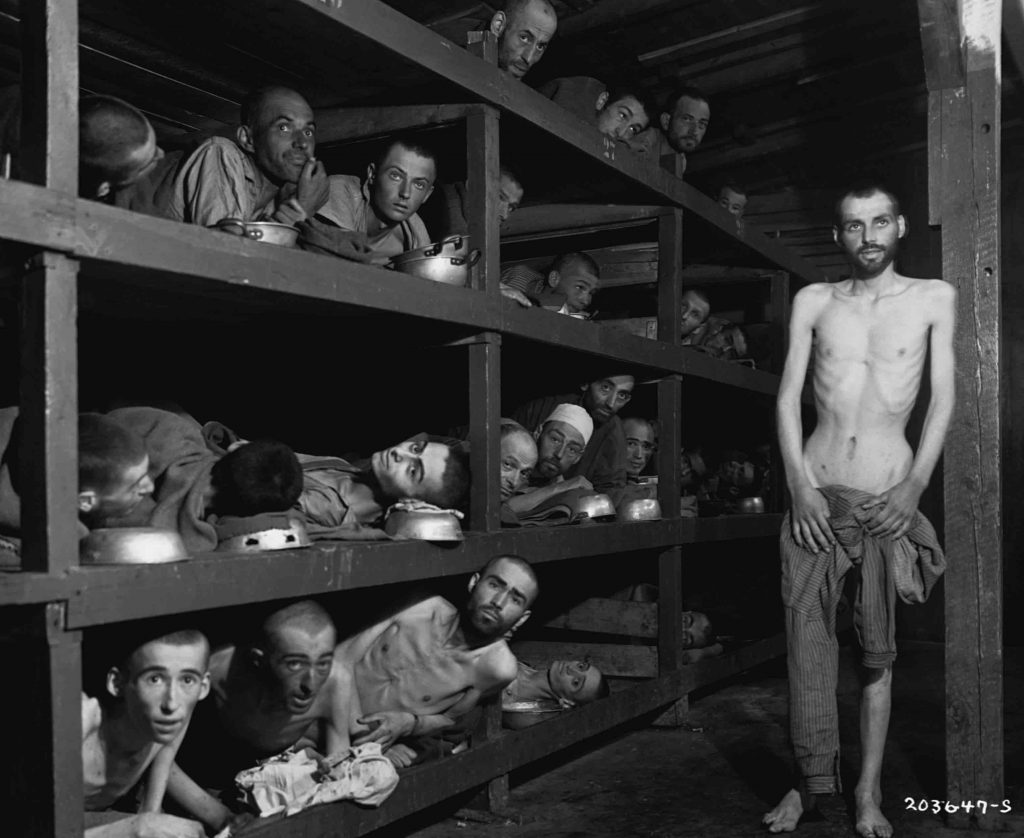
Courtesy – World War 2 National Museum
All these incidents and notions made Jews flee Europe and settle in the region that they considered their home (Israel) since the Old Testament times. It was due to mass exodus that Jews had to leave Israel centuries back.
The hatred among communities for Jews made the Jews more inclined toward creating a separate Jewish state. This is where the term Zionism comes to life.
What exactly is Zionism?
Zionism is considered to be an ideology of the Jews relating to the establishment and protection of Israel. Zionists believe that Judaism is a religion as well as a nationality. This means that Zionists believe that they should have a separate Jewish state.
Palestinians have always opposed Zionism because it acts as a threat to their land. Israel is the only state in the world that allows Jews from anywhere in the world to settle in there. From Palestine’s perspective, this means an increasing population of Jews. This can pose a threat to them, pushing them into the minority, and capturing more of their land.
Where are Israel and Palestine located?
Before 1948, when Israel came into existence, Palestine was the region between the Mediterranean Sea and the Jordan River. Today, most part of the region is taken over by Israel. Palestine has been reduced to control a part of the West Bank (bordering Israel and Jordan) and the entire Gaza Strip (bordering Egypt and Israel).
The West Bank is located to the west of the Jordan River. It is bordered by Jordan to the east and Israel to the south, west, and north.
The Gaza Strip, on the other hand, is a small boot-shaped territory along the Mediterranean coast between Egypt and Israel.
A brief history of Palestine
Palestine, as stated earlier, was originally a region between the Mediterranean Sea and the Jordan River. The Arab Muslims who have been residing in this region are known as Palestinians.
Palestine, though a small piece of land, has been the focal point of conflicts and violence for many years. The region majorly consisted of Arabs until the influx of Jews changed the whole scenario. The land also holds significance for both Jews and Arabs because of Jerusalem. It is a holy city for both Judaism and Islam. Thus, there has been a prolonged fight between the two communities to keep Jerusalem as their capital.
The term “Palestine” is supposed to originate from the word “Philistia” which refers to Philistines who occupied the region somewhere in 12th century B.C. The region has been ruled by many (Greeks, Romans, Arabs, etc.) over the years. The Ottoman Empire ruled the region for almost 400 years from 1517 to 1917.
Mandate of Palestine
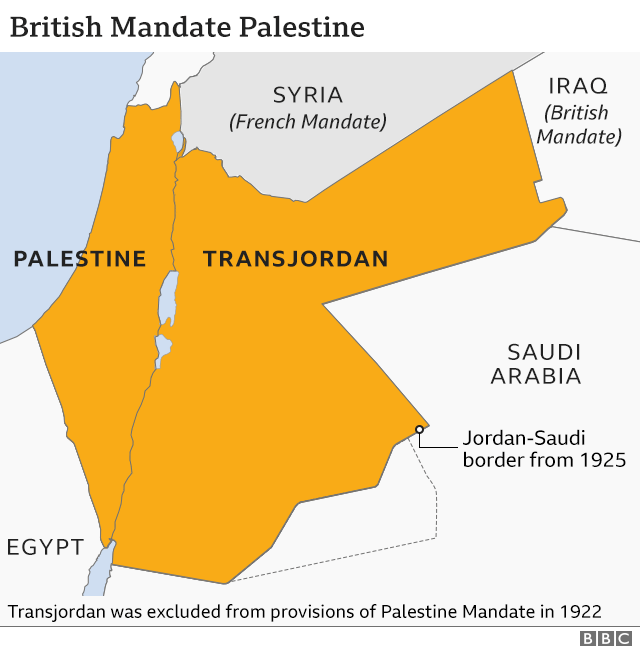
Courtesy – BBC
World War 1 ended in 1918, post which Palestine came under British rule. A British Mandate of Palestine was drafted in 1920 which actually came into existence in 1923. Drafted by the League of Nations, the mandate stated that the British shall rule over the parts of Levant that consisted of countries to the east of the Mediterranean that were previously under the rule of the Ottoman empire. It stated that the League of Nations shall rule the region till the countries in the region become capable.
The mandate also gave Britain the responsibility to create a Jewish homeland in the administered region.
In 1917, the British had already supported the idea of a Jewish state and with the League of Nations had started laying the ground rules. The Jews started migrating from Europe to then Palestine due to religious persecution. This created panic within the Arabs and proved a focal point for many conflicts in the years to come.
Post World War 2, it became difficult for Britain to keep the Mandate of Palestine in place. Though Britain was already wearied by the tensions and conflicts between Arabs and Jews after the mandate came into effect. Britain finally decided to end the mandate in 1948. They left the fate of Palestine in the hands of the United Nations.
United Nations
United Nations agreed to the Mandate of Palestine and in 1947 drafted a plan for the partition of Palestine into two states (one for Jews and the other for Arab Muslims) which was approved by the U.N. General Assembly, accepted by the Jews, but rejected by the Arab world. Jerusalem which was the disputed city (both Jews and Arabs wanted it to be their capital) was supposed to be treated as an international territory with special status.
As per the Mandate of Palestine, approximately 53% of the land was to be allocated for the Jewish state, and the rest 47% for Palestine.
As soon as the Mandate was terminated by Britain, Israel declared itself an independent state in 1948. This was the start of the endless war between the two states.
The war of 1948 between Israel and the Arab States
Soon after Israel declared itself as an Independent state in 1948, the Arab Palestinians regarded it as an unjust move because it was against their territorial integrity. Also, the Arabs were not in favor of the idea that a part of their population would be under the control of the Jewish community.
As a consequence, the forces of Arab countries Iraq, Jordan, Egypt, and Syria joined hands with Palestine Arabs. Together, they declared war on Israel. The motive of the Arab Nations was to block the creation of the Jewish state and keep the territory under their control. Israel, on the other hand, was fighting to keep its territory that was finalized in the Mandate of Palestine intact.
The conflict was brutal and Israel defeated the Arab states capturing more Palestine land than that was allotted to them as part of the Mandate of Palestine. After the war, apart from the West Bank and eastern quarter of Jerusalem (under the control of Jordan) and the Gaza Strip (under the control of Egypt at the end of the war), all the other territory was controlled by Israel.
A total of around 700,000 Palestinians turned into refugees due to the war. A truce was formally agreed upon by Israel and other Arab states in March of 1949. Egypt and Jordan kept control of the Gaza Strip and West Bank respectively. While Israel kept the territory that they occupied.
The 1948 exodus of Palestinians is also known as Nakba.
The Six-Day War of 1967 between Israel and the Arab States
The Six-Day War of 1967 between Israel and the Arab states of Egypt, Syria, and Jordan took place between June 5 to June 10.
A major war broke out in 1956 between Egypt and the United Kingdom, France, and Israel when Egypt nationalized the Suez Canal. The era of the late 1950s and early 1960s was pretty calm but still, the political situation was on the edge.
The war of 1948 had left a deep scar on the Arab states and they hadn’t come to terms with the idea of a Jewish state in the Palestine territory. Israel, on the other hand, knew that the Arab forces will not back down easily and they still posted a threat.
The pre-war crisis
The attacks as part of the conflict between Palestine (and other Arab states) and Israel did not mellow down. In April 1967, a massive air battle broke out between Israel and Syria. Six of the Syrian fighter jets were destroyed by Israel in the war.
At the same time, the Soviet Union gave inaccurate information to Egypt that Israel is moving its troops to its northern border with Syria for invasion. As an ally of Syria, Egyptian President Gamal Abdel Nasser moved his troops to the Sinai Peninsula and withdrew United Nations Emergency Force (UNEF).
Later, Gamal banned Israel shipping from the Straits of Tiran, thus restricting the sea movement of Israel. Egypt and Jordan later also signed a defense pact to back each other in case of a war situation.
The United States attempted to re-open the Straits of Tiran with the help of the international community and the International Maritime Organization, but nothing was concluded.
Considering the buildup of Arab forces around Israel, its leaders in the early June of 1967 voted to launch a pre-emptive strike. This was the start of the Six-Day war.
The Six-Day War
A deadly Six-Day war initiated “Operation Focus” on June 5, 1967, with Israel launching airstrikes on Egypt.
The aerial strike was unexpected and brutal from Egypt’s point of view. The Israel air force destroyed around 18 Egyptian airbases and approximately two-thirds of Egypt’s air force fleet.
Israel later destroyed the air forces of Jordan, Iraq, and Syria. At the end of June 5, the first day of the battle, Israel showed its might and established control over the skies of the Middle East.
Meanwhile, the battle continued on the ground. The Israel military forced into the Sinai Peninsula and the Gaza Strip and initiated the offensive. The Egyptian forces had to retreat. As Israel gained an advantage, heavy casualties were inflicted on the Egyptian side.
On the other hand, Jordan began shelling the Israeli positions in Jerusalem. Israel initiated a counter-attack so brutal that not only many people were killed in the crossfire, but Israel also captured Eastern Jerusalem and the West Bank which was under the control of Jordan.
By June 7, Israel had full control of Jerusalem.
On June 9, Israel captured the region Golan Heights in Syria through aerial attacks and military operations.
The United Nations brokered a ceasefire on June 10, 1967, and the war came to an end. It was estimated that over 20,000 Arabs and over 800 Israelis were killed in the Six-Day war.
Israel now had more control over the region than it had in 1948. Israeli forces captured the Sinai Peninsula and the Gaza Strip under the control of Egypt, Golan Heights from Syria, and West Bank and East Jerusalem from Jordan.
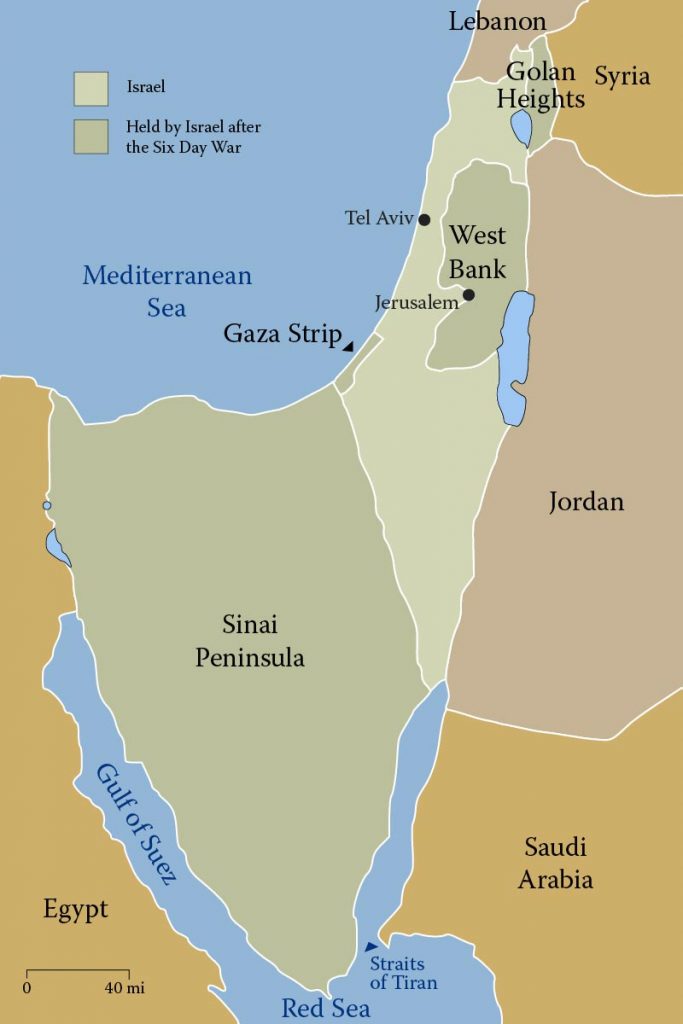
Courtesy – Landmark Events
War of Attrition and Yom Kippur War
The Sinai Peninsula was captured by Israel from Egypt in the Six-Day war. This led to multiple conflicts between Egypt and Israel. One such conflict was the War of Attrition that commenced between Israel and Egypt, Jordan, and PLO forces. The War led to a huge number of casualties and Egyptian refugees. The war that started in 1967 ended in 1970 with no conclusion. The Peninsula still remained under the control of Israel.
In 1973, Egypt launched an operation by the name of Operation Badr to reclaim Sinai while Syria launched a parallel operation to reclaim Golan Heights. These operations led to the start of the Yom Kippur War (also known as the October War and Ramadan War). The war saw the United States and the Soviet Union helping their allies Israel and Egypt respectively. A ceasefire was brokered by United Nations and the war ended on October 26, 1973, with casualties on both sides.
Later, Israel, Syria, and Egypt signed ceasefire agreements to bring a formal end to the war.
Camp David Accords
Few years after the Yom Kippur War, Egyptian President Anwar el-Sadat and Israel Prime Minister Menachem Begin started peace talks to re-establish diplomatic and commercial ties.
Sadat’s peace process initiation with Israel was met with criticism from the Arab states. In September of 1978, both the premiers met in the United States at Camp David and signed a peace agreement in the presence of U.S. President Jimmy Carter. The Camp David accords were the first peace agreement between the two nations. Seven months after, a formal peace treaty was signed.
With Sadat’s peace process initiation, Egypt was suspended from the Arab League and later the extremists assassinated him in 1981. In 1982 Israel and Egypt formally restored diplomatic relations and Israel withdrew its forces from the Sinai Peninsula with Egypt taking over the territory.
Palestine Liberation Organization (PLO)
With multiple organizations fighting for the liberation of Palestine, a need to have a central organization to represent Palestine people emerged. With this thought in mind, the Palestine Liberation Organization or PLO was formed in 1964 during the Arab League Summit. Its motive was to create a Palestinian Arab state in the earlier Palestine region under the British Mandate using an armed struggle. PLO always considered Israel to illegally occupy their territory. While Israel saw PLO as a terrorist organization.
PLO came into prominence after the Six-Day War and fought on the side of the Arab States in the conflicts against Israel. A group called Fatah increased its presence in the PLO and started dominating the organization.
In 1969, the leader of Fatah, Yasser Arafat, became the chairman of the PLO and held the office till he died in 2004.
PLO initially had a base in Jordan from where they launched attacks on Israel. Later in 1971, PLO had to move to Lebanon.
In years to come, some internal groups in PLO started to plot terrorist attacks in and outside Israel which were later condemned by Arafat. Arafat was against any operation outside Israel and in the favor of gaining global acceptance for Palestine. In 1974, the Arab League recognized PLO as a legitimate representative for Palestine.
In the year 1982, when Egypt and Israel formally restored their relationship, PLO moved its base to Tunisia after which it relocated to Gaza in 1994.
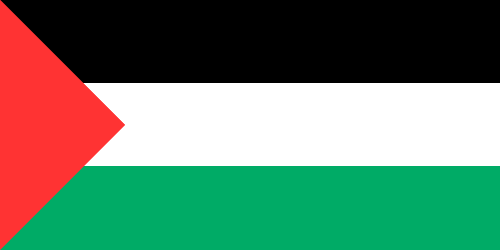
Courtesy – Britannica
The First Intifada of Israel and Palestine Conflict
The Intifada was the Palestinian uprising against Israel. The First Intifada took place in 1987. It was aimed at the resentment of Palestinians against the Israel occupation of the West Bank and the Gaza Strip. The Intifada consisted of Palestinian demonstrations and they boycotting their jobs in Israel. It also consisted of occasional armed conflict by Palestinian groups. Hundreds of people died in the conflict. The casualties in the conflict were higher on the Palestine side as Israel used brute force to suppress the movement.
The First Intifada ended with a subsequent peace process known as Oslo Peace Accords.
Oslo Accords to end Israel and Palestine Conflict
After the First Intifada, Oslo Peace Records were created to end the conflict and initiate the peace process between Israel and Palestine.
Oslo Accord (Oslo I) was created keeping in mind the peace process between the two states and creating an interim Palestinian government in parts of the West Bank and Gaza Strip.
The agreement was signed in 1993 in Washington D.C. in the presence of Israeli Prime Minister Yitzhak Rabin and PLO leader Yasser Arafat. It was then that Israel for the first-time recognized PLO as a representative for the Palestinian people, and PLO recognized the state of Israel.
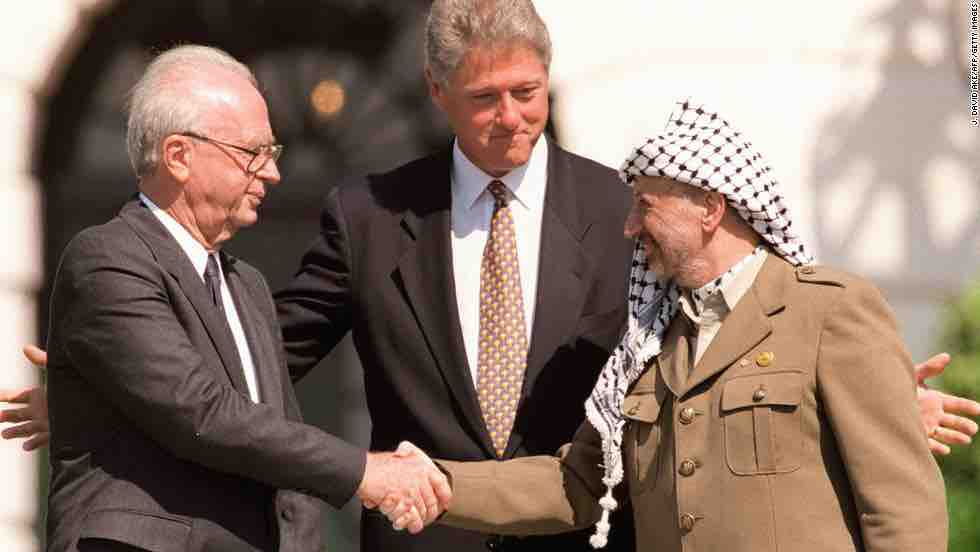
Courtesy – CNN
Yasser Arafat returned to Gaza in 1994 and headed the Palestinian Authority (PA) which was created as part of the accords and acted like a sub-group of the PLO that would govern Gaza and some parts of West Bank.
In 1995, the Oslo Accord (Oslo II) was signed in Taba, Egypt. The accord consisted of the withdrawal of Israeli forces from parts of the West Bank and some other regions, and elections for the Palestinian Legislative Council.
The Oslo Accords, however, never materialized as both Palestine and Israel never came to a common ground for the peacekeeping process. The Oslo process ended when the Second Intifada began.
The Second Intifada of Israel and Palestine Conflict
In September of 2000, the second and the bloodier of the two intifadas began. This conflict between Israel and Palestine was triggered when Ariel Sharon (who later became Prime Minister of Israel), a Jewish Israeli, visited the al-Aqsa Mosque in Jerusalem. This visit didn’t go down well with the Palestinians and they protested the move.
The earlier negotiations between Israeli Prime Minister Ehud Barak and Yasser Arafat broke down. A feeling of mistrust crept in between both sides. Thousands of Israelis and Palestinians were killed in the conflict.
The intifada consisted of riots, suicide bombing attacks, and mass killings. The Second Intifada made Oslo Accords futile and the hostility between Palestine and Israel renewed.
The Intifada continued for the next five years till 2005 when Israel forces withdrew from Gaza Strip.
Yasser Arafat died in November 2004
Hamas’s role in Israel and Palestine Conflict
In the early 2000s, a Sunni Islamist group Hamas came to the forefront in Palestine. It has been treated as a terrorist organization by many countries because of the way of their operation like suicide bombings, rocket attacks, etc. They have always been in favor of the destruction of Israel. In their updated charter in 2017, Hamas accepted that the control of the West Bank and Gaza be given to Palestine instead of the whole region inclusive of Israel. But, Hamas, still hasn’t recognized Israel as a legitimate state and therefore there have been no further negotiations.
The group won the Palestinian legislative elections in 2006.
A fight between Hamas and Fatah (a group that controlled PLO) ensued in 2007 for Gaza Strip where Fatah was defeated.
Over the years Israel and Hamas have fought many battles. Israel launched various operations like Operation Cast Lead, Operation Pillar, and Operation Protective Edge on Hamas in 2008, 2012, and 2014 respectively.
In 2014, Hamas and Fatah joined hands to form a unified Palestinian government.
Current Status of the Israel Palestine Conflict
After so many years, the relationship between Israel and Palestine still remains the same and the conflict is far from resolved. Palestinians are fighting to establish a state of their own while Israel is fighting to defend its territory. The regions of West Bank and Gaza Strip are home to many Palestinians and Israelis. Though Palestine continues to stake a claim on West Bank and Gaza Strip, Israel is ready to counter any unwanted move from Palestine.
Differences in opinions and rejecting the legitimacy of the territory occupied have always hindered the peace process between the two parties.
Later, as part of the negotiations and as per the Oslo accords, a part of the West Bank came under the Palestinian Authority’s control. PA controls approximately 40% of the region while the other parts are under the control of Israel.
The Gaza Strip is currently controlled by Hamas.
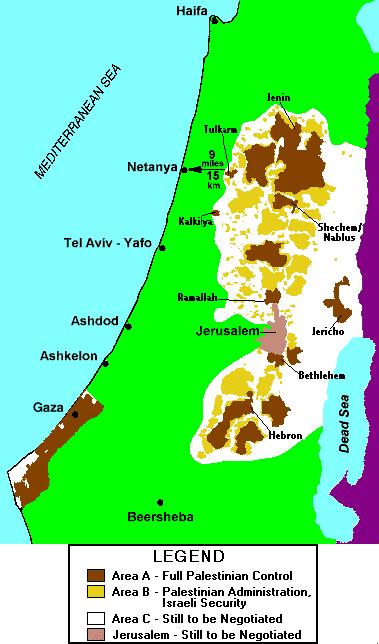
Courtesy – Jewish Virtual Library
Initiatives by the International Community
The Arab Peace Initiative
The Saudi Initiative or Arab Peace Initiative is a proposal to end the conflict between Israel and the Arab States. It was endorsed by Arab League in 2002 and later in 2007 and 2017.
The proposal consisted of the initiation of peace talks between the Arab States and Israel for stability in the region. Israel should withdraw its forces from the territories: Gaza, West Bank, Golan Heights, and Lebanon, and that a state of Palestine should be formed with East Jerusalem as its capital was drafted in the initial proposal.
The Israeli government has always raised concerns over the proposal. It was rejected by Israel, then revised by the Arab States with help of the Barack Obama administration, re-endorsed by Arab League, but then again rejected by Israel.
The Middle East Quartet
The Quartet of the Middle East or the Middle East Quartet was formed in 2002 with the United States, the European Union, Russia, and the United Nations as its members. It is aimed to resolve the issues between Israel and Palestine via negotiations and talks, adhere to the idea of two-states, and enhance Palestine’s economy and growth.
Factors that make the Israel Palestine Conflict Complex
Border
Palestine wants the borders to be marked as they were prior to the Six-Day War in 1967. Israel, on the other hand, opposes this proposal as it will lead to the displacement of thousands of Israelis, and Israel will have to re-strategize from a security perspective.
Security
Israel’s top priority has always been security. The surrounding Arab states can be a threat to Israel at any given point in time. For example, Israel has deployed its troops across West Bank – Jordan border to maintain its territorial integrity.
Refugees
Palestinians have always supported the idea of returning to their homeland after their exodus in 1948 and where Israel exists now. Israel opposes this idea as an influx of Palestinians will be a threat to Israel’s security and will change the essence of what Israel is all about.
Jerusalem
Both Palestine and Israel have staked a claim on the holy city to be their capital and that has been one of the major factors of the conflict.
Mutual Recognition
Both Palestine and Israel have locked horns when it comes to recognizing each other as separate states. Even if there has been an understanding, the other factors as detailed above have derailed the talks.
Role of the United States
In recent years, the United States administration has accepted Jerusalem to be the capital of Israel. They even moved the US embassy from Tel Aviv to Jerusalem. This has caused Palestinians to disengage from any talks with the United States. For non-cooperation, the US has put restrictions on the United Nations funding agency that supplies food, education, housing, etc. for the Palestinian refugees in West Bank and neighboring countries. The Trump administration backed this strategy to force Palestine to restart the negotiations.
One-state Solution
If Israel goes for a one-state solution, then it will have to incorporate millions of Palestinians into West Bank and Gaza. This will create regions with Palestinians as the majority. This will again be a threat to Israel and Jewish Israelis will never accept this solution.
Good Reads and References
CURATED & WRITTEN BY
AYUSH PANDYA
(AUTHOR- THE UNPRECEDENTED CULT)